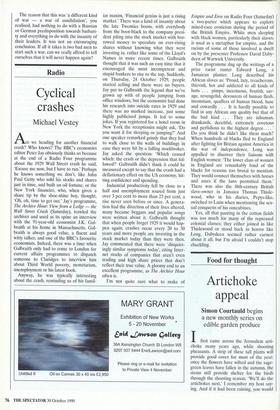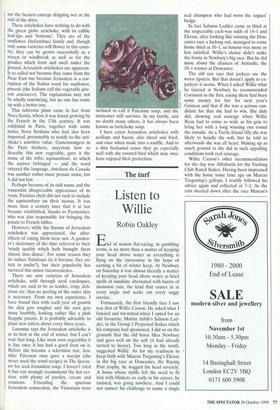Food for thought
Artichoke appeal
Simon Courtauld begins a new monthly series on edible garden produce Ifirst came across the Jerusalem arti- choke many years ago, while shooting pheasants. A strip of these tall plants will provide good cover for most of the year; once the flowers have wilted and the sage- green leaves have fallen in the autumn, the stems still provide shelter for the birds through the shooting season. 'We'll do the artichokes next,' I remember my host say- ing. And if it had been raining, you would
see the beaters emerge dripping wet at the end of the drive.
These artichokes have nothing to do with the green globe artichoke, with its edible leaf-tips and 'bottoms'. They are of the sunflower (helianthus) family and, though only some varieties will flower in this coun- try, they can be grown successfully as a screen or windbreak as well as for the goodies which form and swell under the ground. Jerusalem artichokes are apparent- ly so called not because they come from the Near East but because Jerusalem is a cor- ruption of the Italian word for sunflower, girasole (the Italians call the vegetable gira- sole articiocco). The explanation may not be wholly convincing, but no one has come up with a better one.
This tuberous plant came in fact from Nova Scotia, where it was found growing by the French in the 17th century. It was exhibited in Paris, together with some native Nova Scotians who had also been imported, presumably to testify to the arti- choke's nutritive value. Costermongers in the Paris markets, uncertain how to describe this new vegetable, gave it the name of the tribe, topinambour, to which the natives belonged — and the word entered the language. Artichaut du Canada was another rather more prosaic name, but it did not last.
Perhaps because of its odd name and the somewhat disagreeable appearance of its roots, Parisian chefs did not rush to include the topinambour on their menus. It was more than a century later that it at last became established, thanks to Parmentier, who was also responsible for bringing the potato to French tables.
However, while the flavour of Jerusalem artichokes was appreciated, the after- effects of eating them were not. A garden- er's dictionary of the time referred to their 'windy quality which hath brought them almost into disuse'. For some reason they do induce flatulence (is it because they are rich in inulin?), but their popularity has survived this minor inconvenience.
There are now varieties of Jerusalem artichoke, sold through seed catalogues, which are said to be so tender, crisp, deli- cious etc. that no peeling of the outer skin is necessary. From my own experience, I have found that with each year of growth the skin gets tougher and the root gets more knobbly, looking rather like a pink firapple potato. It is probably advisable to plant new tubers about every three years.
Larousse says the Jerusalem artichoke is at its best at the end of winter, but I can't wait that long. Like most root vegetables it is fine once it has had a good frost on it. Before she became a television star, Jen- nifer Paterson once gave a receipt (she never used the word recipe) in The Specta- tor for iced Jerusalem soup. I haven't tried it but can strongly recommend the hot ver- sion, with plenty of parsley, cream and croutons. Extending the spurious Jerusalem connection, the Victorians were inclined to call it Palestine soup, and the misnomer still survives. In my family, and no doubt many others, it has always been known as fartichoke soup.
I have eaten Jerusalem artichokes with scallops and bacon, also sliced and fried, and once when made into a soufflé. And in a thin bechamel sauce they go especially well with the roasted bird which may once have enjoyed their protection.



























































































 Previous page
Previous page